
NAMMbulating 2013
NAMM Convention January 2013, Anaheim, CA
Page 3 of 3
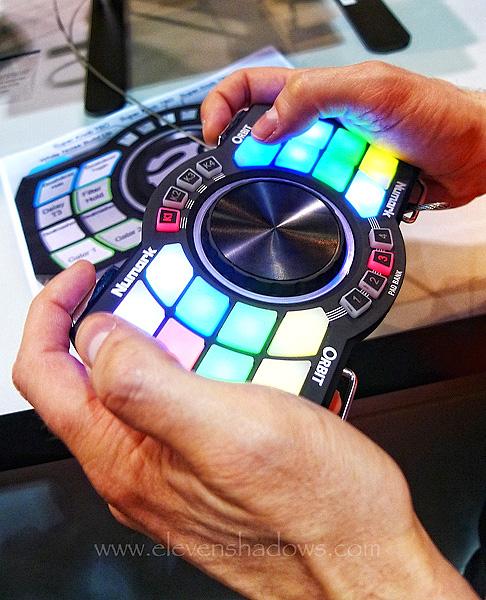 Gus showed us this clever Numark Orbit MIDI DJ Controller, which is completely wireless (the cable you see is to prevent us from running away with it). Apparently, you can use this all the way across a large stadium. Seemed very responsive. Gus showed us this clever Numark Orbit MIDI DJ Controller, which is completely wireless (the cable you see is to prevent us from running away with it). Apparently, you can use this all the way across a large stadium. Seemed very responsive. |
These are two keyboards, the small one on top the M4000D Mini (US$2000), and the one below the full M4000D (US$2800). The larger M4000D has wooden keys, depth sensitivity, and polyphonic aftertouch via MIDI out, and comes with 100 original Mellotron and Chamberlin sounds with immediate access. That's right, no having to change tapes. There's also an expansion slot so you can stuff another 100 sounds on compact flash cards. All of these sounds are from the original archives. The Foo Fighters, Red Hot Chili Peppers, Wilco, Queens of the Stone Age, Fleet Foxes, and others use this. The smaller M4000D Mini has the same features, but has a Fatar piano keyboard with velocity sensitivity and has a sheet metal cabinet instead of a wooden cabinet. Although the aftertouch simulates the real Mellotron, both Chris and I agreed that we'd be quite happy with the smaller and more portable Mini. Oh, and the sounds? Did I mention that they sound really good? |
One of the main reasons I'm interested in the UAD Apollo is because I could add on the UAD Massive Passive. But in reality, I probably won't get the UAD Apollo any time soon. Here's the thing about the Massive Passive for me. I don't remember when I first fiddled with it. I'm sure it was when it first came out. Eveanna invited me to come by the booth. I did. I messed with the Massive Passive. At the time, the only EQ I had ever really used was the EQ on the Akai MG1214 12-track board, and that EQ was....well, I felt like I could rarely boost anything because it didn't sound right to me. It often sounded strident, forced, sometimes downright amusical. But using the Massive Passive on various material, I almost wanted to cry. It seemed like whatever EQ I applied - boost, cut, this, that - sounded musical. Sonorous. Right. It just sounded like how I had always imagined EQ would work. I had a strong idea just how crappy my EQ was, but this jumped up and down and screamed to me that it was. This was gorgeous, absolutely gorgeous. I can't afford this. Well, I suppose I could. Yes, I could without needing to sell my car. But no, I need to save money, and I don't think I can legitimately warrant this purchase. But if I win the lottery, you can be sure that I will purchase this glorious EQ. |
|
|
Imagine what seems like hundreds of drum sets, all in one big room. And now imagine hundreds of people, all playing these drum sets. All at once. Continuously.
|
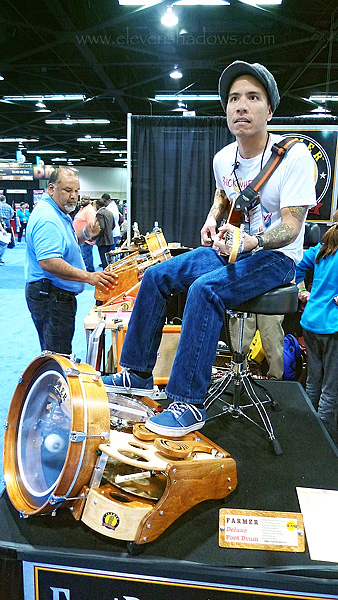 One-man bands will love the Fisher Deluxe Foot Drum. One-man bands will love the Fisher Deluxe Foot Drum. |
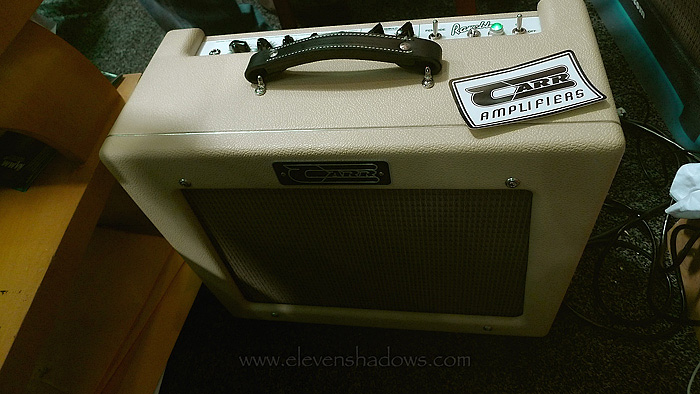 I have a Carr Rambler. It's sweet tone, complex midrange, and amazing tone, all wrapped in a beautiful package that hardly weighs over 40 pounds, is such a great joy to play through, with Tele-style guitars sounding particularly glorious through it. While my amp is black and this one is cream-colored, they're all great. The guy in the booth said that this still continues to be one of their best sellers along with the Carr Mercury. I think that the Carr Rambler is one of the most beautiful sounding guitar amps I've ever heard, and I'm darn lucky to have one. I have a Carr Rambler. It's sweet tone, complex midrange, and amazing tone, all wrapped in a beautiful package that hardly weighs over 40 pounds, is such a great joy to play through, with Tele-style guitars sounding particularly glorious through it. While my amp is black and this one is cream-colored, they're all great. The guy in the booth said that this still continues to be one of their best sellers along with the Carr Mercury. I think that the Carr Rambler is one of the most beautiful sounding guitar amps I've ever heard, and I'm darn lucky to have one. |
And actually, on this day, I got lucky twice. Well, actually, more than that, because I kept running into friends. But in terms of what was going on at the booths, I first caught Stevie Wonder playing harp at the Suzuki booth. The second thing was watching Andy McKee play acoustic guitar at the Ernie Ball booth. So beautiful. I first caught him doing an interesting version of Toto's "Africa", followed by his original compositions, which were exquisite. Sure, he can play amazing guitar, but more importantly, the guy can write a song. Dan (RedKeys) was there from last night's dinner, taking photos with his Fuji X100. |
The YouRock MIDI guitar tracked....well, not bad. As someone who doesn't play MIDi guitar, it takes some adjusting. And that includes not being able to bend notes or slide. But fretting and strumming chords was easy, as was the tremolo bar, which was surprisingly smooth. The YouRock guitar had quite a number of different sounds, and didn't seem to have any latency. It's compatible with Logic, Garage Band, Sonar, Reason via USB and has a removable neck so you can stuff it in a backpack. And it's $250. Not the one pictured here. The one in the photo is a prototype that will probably be about $600 or more, and has many more features. |
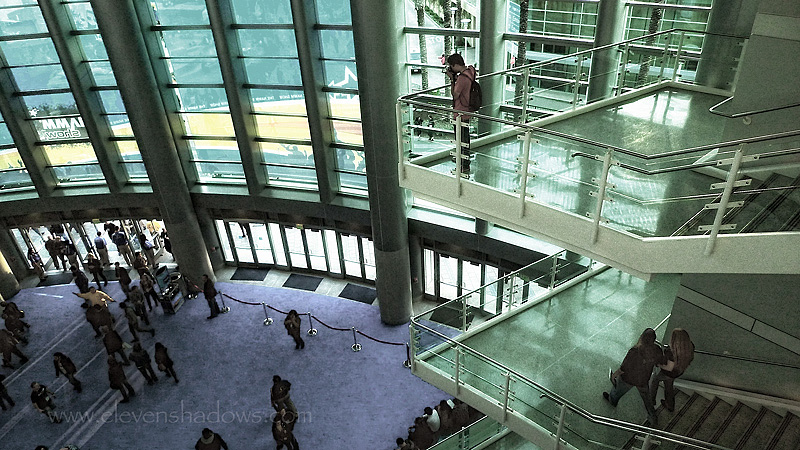 The Anaheim Convention Center in all its glory. Yes, I messed with the colors a bit because I was bored and didn't like the dark blue carpeting. This is sort of a combination of natural color and B&W blended together. The Anaheim Convention Center in all its glory. Yes, I messed with the colors a bit because I was bored and didn't like the dark blue carpeting. This is sort of a combination of natural color and B&W blended together. |
On the far left of the table, behind the jar of icewater, is the rather rare Moog String Filter, a filter bank and string filter that was handmade by Bob Moog. One audience member asked Boddicker, "How is it that you don't use that on every session?" Here's the Moog Foundation description of the one-hour tribute: |
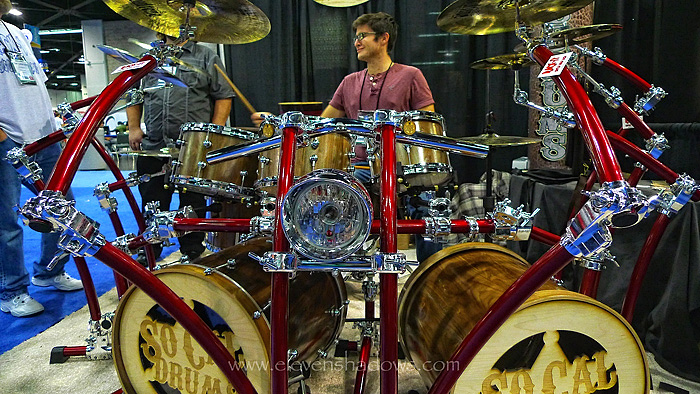 I forgot to stick this photo in chronological order. This is So Cal Drums. Because you need a headlight on your drums. I forgot to stick this photo in chronological order. This is So Cal Drums. Because you need a headlight on your drums. |
The Wheelharp is a groundbreaking keyboard musical instrument that gives the player the ability to orchestrate a full chromatic scale of sixty-one (61) actual bowed strings at one’s own fingertips, almost like having a real chamber string orchestra at hand. With an exotic profile and stunning rosette appointments, the Wheelharp’s appearance is equally as breathtaking as its audible character. It is available in a Radial Model (curved keyboard) and a Linear Model (traditional straight keyboard), and in several ranges. It utilizes a patent-pending action and bridge to translate the player’s subtle fingerings into a range of bowing intensities, and comes equipped with a damper system and electronic pickup system, allowing individuals to sculpt astonishingly beautiful and complex sounds. For musicians, composers, and studios that seek to create the natural sound of classical string instruments while avoiding the frequently sterile quality of digital string synthesizers and samples, or for those looking to foray into new sonic territory, the Wheelharp presents a truly exciting opportunity. So to sum up how one plays it, you basically play the keyboard (curved, shown here, or linear, not shown here) while pressing a pedal, which spins the thing. You need a light touch on the keyboards, as the keyboard applies pressure to the strings, and can bend 'em out of tune in a hurry, which can probably make listeners seasick in a hurry. Two freakin' thumbs up for creating something this cool, this beautiful, and this original. |
This time at NAMM, I went to more classes, away from the NAMM floor, and didn't stop by Rupert Neve Designs, Electro-Harmonix (who had the new HOG 2), or Nord. I did stop by Pigtronix to see some new pedals, but otherwise, it was just hard to cram everything in. Both days I skipped lunch. The first day, I had a breakfast burrito with chorizo and a pipin' hot champurrado (sort of like hot chocolate) at a Mexican restaurant in Katella. The second day, I had Oaxacan tamales and an horchata. By the second day, I had a good appetite while driving home in the rain, but I was soon at home eating my girlfriend's homemade pizza. |
|
Ken's photos of Nobel Peace Prize Winner Aung
San Suu Kyi, as well as photos of Peru, Burma, India, Morocco, China, Thailand,
Ghana, Ecuador, and elsewhere, have appeared in many books, magazines,
websites, and galleries. Visit the
Ken Lee Photography Website. Some of Ken's select photos may be
purchased through his
Imagekind Store. |
NAMMbulating, January 2013
Page 3 of 3
Eleven Shadows Travel Page
Contact photographer/musician Ken Lee